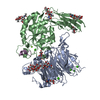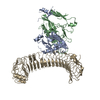登録情報 データベース : EMDB / ID : EMD-43494タイトル avb8/L-TGF-b1/GARP L-TGF-b1/GARP/avb8 複合体 : avb8/L-TGF-b1/GARP complex複合体 : avb8 complexタンパク質・ペプチド : Integrin alpha-V heavy chainタンパク質・ペプチド : Integrin beta-8複合体 : L-TGF-b1/GARP complexタンパク質・ペプチド : Transforming growth factor beta activator LRRC32タンパク質・ペプチド : Transforming growth factor beta-1 proproteinリガンド : 2-acetamido-2-deoxy-beta-D-glucopyranoseリガンド : CALCIUM IONリガンド : MAGNESIUM ION / / 機能・相同性 分子機能 ドメイン・相同性 構成要素
/ / / / / / / / / / / / / / / / / / / / / / / / / / / / / / / / / / / / / / / / / / / / / / / / / / / / / / / / / / / / / / / / / / / / / / / / / / / / / / / / / / / / / / / / / / / / / / / / / / / / / / / / / / / / / / / / / / / / / / / / / / / / / / / / / / / / / / / / / / / / / / / / / / / / / / / / / / / / / / / / / / 生物種 Homo sapiens (ヒト)手法 / / 解像度 : 3.2 Å Jin M / Cheng Y / Nishimura SL 資金援助 Organization Grant number 国 National Institutes of Health/National Heart, Lung, and Blood Institute (NIH/NHLBI) HL134183
ジャーナル : Cell / 年 : 2024タイトル : Dynamic allostery drives autocrine and paracrine TGF-β signaling.著者: Mingliang Jin / Robert I Seed / Guoqing Cai / Tiffany Shing / Li Wang / Saburo Ito / Anthony Cormier / Stephanie A Wankowicz / Jillian M Jespersen / Jody L Baron / Nicholas D Carey / Melody G ... 著者 : Mingliang Jin / Robert I Seed / Guoqing Cai / Tiffany Shing / Li Wang / Saburo Ito / Anthony Cormier / Stephanie A Wankowicz / Jillian M Jespersen / Jody L Baron / Nicholas D Carey / Melody G Campbell / Zanlin Yu / Phu K Tang / Pilar Cossio / Weihua Wen / Jianlong Lou / James Marks / Stephen L Nishimura / Yifan Cheng / 要旨 : TGF-β, essential for development and immunity, is expressed as a latent complex (L-TGF-β) non-covalently associated with its prodomain and presented on immune cell surfaces by covalent association ... TGF-β, essential for development and immunity, is expressed as a latent complex (L-TGF-β) non-covalently associated with its prodomain and presented on immune cell surfaces by covalent association with GARP. Binding to integrin αvβ8 activates L-TGF-β1/GARP. The dogma is that mature TGF-β must physically dissociate from L-TGF-β1 for signaling to occur. Our previous studies discovered that αvβ8-mediated TGF-β autocrine signaling can occur without TGF-β1 release from its latent form. Here, we show that mice engineered to express TGF-β1 that cannot release from L-TGF-β1 survive without early lethal tissue inflammation, unlike those with TGF-β1 deficiency. Combining cryogenic electron microscopy with cell-based assays, we reveal a dynamic allosteric mechanism of autocrine TGF-β1 signaling without release where αvβ8 binding redistributes the intrinsic flexibility of L-TGF-β1 to expose TGF-β1 to its receptors. Dynamic allostery explains the TGF-β3 latency/activation mechanism and why TGF-β3 functions distinctly from TGF-β1, suggesting that it broadly applies to other flexible cell surface receptor/ligand systems. 履歴 登録 2024年1月23日 - ヘッダ(付随情報) 公開 2024年9月11日 - マップ公開 2024年9月11日 - 更新 2024年11月20日 - 現状 2024年11月20日 処理サイト : RCSB / 状態 : 公開
すべて表示 表示を減らす
 データを開く
データを開く 基本情報
基本情報
 マップデータ
マップデータ 試料
試料 キーワード
キーワード 機能・相同性情報
機能・相同性情報 Homo sapiens (ヒト)
Homo sapiens (ヒト) データ登録者
データ登録者 米国, 1件
米国, 1件  引用
引用 ジャーナル: Cell / 年: 2024
ジャーナル: Cell / 年: 2024
 構造の表示
構造の表示 ダウンロードとリンク
ダウンロードとリンク emd_43494.map.gz
emd_43494.map.gz EMDBマップデータ形式
EMDBマップデータ形式 emd-43494-v30.xml
emd-43494-v30.xml emd-43494.xml
emd-43494.xml EMDBヘッダ
EMDBヘッダ emd_43494.png
emd_43494.png emd-43494.cif.gz
emd-43494.cif.gz http://ftp.pdbj.org/pub/emdb/structures/EMD-43494
http://ftp.pdbj.org/pub/emdb/structures/EMD-43494 ftp://ftp.pdbj.org/pub/emdb/structures/EMD-43494
ftp://ftp.pdbj.org/pub/emdb/structures/EMD-43494 emd_43494_validation.pdf.gz
emd_43494_validation.pdf.gz EMDB検証レポート
EMDB検証レポート emd_43494_full_validation.pdf.gz
emd_43494_full_validation.pdf.gz emd_43494_validation.xml.gz
emd_43494_validation.xml.gz emd_43494_validation.cif.gz
emd_43494_validation.cif.gz https://ftp.pdbj.org/pub/emdb/validation_reports/EMD-43494
https://ftp.pdbj.org/pub/emdb/validation_reports/EMD-43494 ftp://ftp.pdbj.org/pub/emdb/validation_reports/EMD-43494
ftp://ftp.pdbj.org/pub/emdb/validation_reports/EMD-43494 リンク
リンク EMDB (EBI/PDBe) /
EMDB (EBI/PDBe) /  EMDataResource
EMDataResource マップ
マップ ダウンロード / ファイル: emd_43494.map.gz / 形式: CCP4 / 大きさ: 512 MB / タイプ: IMAGE STORED AS FLOATING POINT NUMBER (4 BYTES)
ダウンロード / ファイル: emd_43494.map.gz / 形式: CCP4 / 大きさ: 512 MB / タイプ: IMAGE STORED AS FLOATING POINT NUMBER (4 BYTES) 試料の構成要素
試料の構成要素 解析
解析 試料調製
試料調製 電子顕微鏡法
電子顕微鏡法 FIELD EMISSION GUN
FIELD EMISSION GUN
 画像解析
画像解析 ムービー
ムービー コントローラー
コントローラー





























 Z (Sec.)
Z (Sec.) Y (Row.)
Y (Row.) X (Col.)
X (Col.)






















